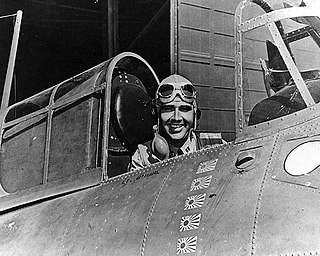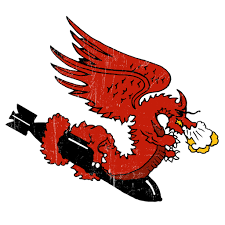
Lieutenant Commander Edward Henry O'Hare was an American naval aviator of the United States Navy, who on February 20, 1942, became the Navy's first fighter ace of the war when he single-handedly attacked a formation of nine medium bombers approaching his aircraft carrier. Even though he had a limited amount of ammunition, he was credited with shooting down five enemy bombers and became the first naval aviator recipient of the Medal of Honor in World War II.

USS Enterprise (CV-6) was a Yorktown-class carrier built for the United States Navy during the 1930s. She was the seventh U.S. Navy vessel of that name. Colloquially called "The Big E", she was the sixth aircraft carrier of the United States Navy. Launched in 1936, she was the only Yorktown-class and one of only three American fleet carriers commissioned before World War II to survive the war. She participated in more major actions of the war against Japan than any other United States ship. These actions included the attack on Pearl Harbor — 18 Douglas SBD Dauntless dive bombers of her air group arrived over the harbor during the attack; seven were shot down with eight airmen killed and two wounded, making her the only American aircraft carrier with men at Pearl Harbor during the attack and the first to sustain casualties during the Pacific War — the Battle of Midway, the Battle of the Eastern Solomons, the Battle of the Santa Cruz Islands, various other air-sea engagements during the Guadalcanal Campaign, the Battle of the Philippine Sea, and the Battle of Leyte Gulf. Enterprise earned 20 battle stars, the most for any U.S. warship in World War II, and was the most decorated U.S. ship of World War II. She was also the first American ship to sink a full-sized enemy warship after the Pacific War had been declared when her aircraft sank the Japanese submarine I-70 on 10 December 1941. On three occasions during the war, the Japanese announced that she had been sunk in battle, inspiring her nickname "The Grey Ghost". By the end of the war, her planes and guns had downed 911 enemy planes, sunk 71 ships, and damaged or destroyed 192 more.

USS Saratoga (CV-3) was a Lexington-class aircraft carrier built for the United States Navy during the 1920s. Originally designed as a battlecruiser, she was converted into one of the Navy's first aircraft carriers during construction to comply with the Washington Naval Treaty of 1922. The ship entered service in 1928 and was assigned to the Pacific Fleet for her entire career. Saratoga and her sister ship, Lexington, were used to develop and refine carrier tactics in a series of annual exercises before World War II. On more than one occasion these exercises included successful surprise attacks on Pearl Harbor, Hawaii. She was one of three prewar US fleet aircraft carriers, along with Enterprise and Ranger, to serve throughout World War II.

USS Bunker Hill was one of 24 Essex-class aircraft carriers built during World War II for the United States Navy. The ship was named for the Battle of Bunker Hill in the American Revolutionary War. Commissioned in May 1943 and sent to the Pacific Theater of Operations, the ship participated in battles in the Southwest Pacific, Central Pacific and the drive toward Japan through Iwo Jima and Okinawa, and air raids on the Japanese homeland.

Torpedo Squadron 8 (VT-8) was a United States Navy squadron of World War II torpedo bombers. VT-8 was assigned initially to the air group of the aircraft carrier USS Hornet, joining the ship shortly after her commissioning in October 1941.

VFA-31 or Strike Fighter Squadron 31 is known as the Tomcatters, callsign "Felix", a United States Navy strike fighter squadron stationed at Naval Air Station Oceana flying the F/A-18E Super Hornet. The Tomcatters are the second oldest Navy Fighter Attack squadron operating today.

A carrier air wing is an operational naval aviation organization composed of several aircraft squadrons and detachments of various types of fixed-wing and rotary-wing aircraft. Organized, equipped and trained to conduct modern US Navy carrier air operations while embarked aboard aircraft carriers, the various squadrons in an air wing have different but complementary missions, and provide most of the striking power and electronic warfare capabilities of a carrier battle group (CVBG). While the CVBG term is still used by other nations, the CVBG in US parlance is now known as a carrier strike group (CSG).

VF-74, Fighter Squadron 74, Be-Devilers was an aviation unit of the United States Navy in service from 1944 to 1994. Originally established as VBF-20 on 16 April 1945, it was redesignated as VF-10A on 15 November 1946, redesignated as VF-92 on 12 August 1948, redesignated as VF-74 on 15 January 1950 and disestablished on 30 April 1994. It was the third US Navy squadron to be designated as VF-74.

USS Mason (DE-529), an Evarts-class destroyer escort, was the second ship of the United States Navy to be named Mason, though DE-529 was the only one specifically named for Ensign Newton Henry Mason. USS Mason was one of two US Navy ships with largely African-American crews in World War II. The other was USS PC-1264, a submarine chaser. These two ships were manned by African Americans as the result of a letter sent to President Roosevelt by the NAACP in mid-December 1941. Entering service in 1944, the vessel was used for convoy duty in the Battle of the Atlantic for the remainder of the war. Following the war, Mason was sold for scrap and broken up in 1947.

USS Oswald A. Powers (DE-542) was a United States Navy John C. Butler-class destroyer escort launched during World War II but never completed.

Ralph Andrew Ofstie was a Vice Admiral in the United States Navy, an escort carrier commander in World War II, Deputy Chief of Naval Operations (Air), and Commander of the U.S. Sixth Fleet. He was born in Eau Claire, Wisconsin and his hometown was Everett, Washington.

Attack Squadron 35 (VA-35) was an aviation unit of the United States Navy. The squadron's nickname is unknown. Its insignia, a winged dragon, was revised several times during its lifetime. The squadron was first established as Torpedo and Bombing Squadron 2 (VT-2) on 6 July 1925, and was redesignated as VT-2B on 1 July 1927, VT-3 on 1 July 1937, VA-4A on 15 November 1946, and, finally, VA-35 on 7 August 1948. The squadron was disestablished on 7 November 1949. It was the first squadron to carry the VA-35 designation, the second VA-35 was redesignated from VA-34 on 15 February 1950 and disestablished on 31 January 1995.

VA-54 was an early and long-lived Attack Squadron of the U.S. Navy, operating under many designations during its 20-year life. It was established as Scouting Squadron VS-2B on 3 July 1928, and redesignated as VS-3 on 1 July 1937, and as Bombing Squadron VB-4 on 1 March 1943. It was redesignated as VB-5 on 15 July of that same year, and as Attack Squadron VA-5A on 15 November 1946. Finally, it was redesignated as VA-54 on 15 November 1946. VA-54 was disestablished on 1 December 1949. The squadron's insignia varied over its lifetime, depicting in turn a bird dog, a devil, and finally a bomb and five playing cards. Its nickname is unknown. It was the first squadron to be designated VA-54, a second VA-54 was redesignated from VF-54 on 15 June 1956 and disestablished on 1 April 1958.

VA-34, nicknamed the Blue Blasters, was an Attack Squadron of the U.S. Navy. The squadron was established as Fighter Squadron VF-20 on 15 October 1943, redesignated as VF-9A on 15 November 1946, as VF-91 on 12 August 1948, and as VF-34 on 15 February 1950. It was finally redesignated VA-34 on 1 July 1955. The squadron was disestablished on 1 June 1969. It was the second squadron to bear the VA-34 designation, the first one having been renamed VA-35 in 1950.
Fighter Squadron 13 or VF-13 was an aviation unit of the United States Navy. Established on 2 November 1943, it was disestablished on 20 October 1945. It was the first US Navy squadron to be designated as VF-13.
Fighter Squadron 71 or VF-71 was an aviation unit of the United States Navy. Originally established as VGS-18 on 15 October 1942, it was redesignated VC-18 on 1 March 1943, redesignated as VF-36 on 15 August 1943, redesignated as VF-18 on 5 March 1944, redesignated as VF-7A on 15 November 1946, redesignated as VF-71 on 28 July 1948 and disestablished on 31 March 1959.
Fighter Squadron 1 (VF-1) was a fighter squadron of the United States Navy. Originally established as Fighter Squadron 4 (VF-4) on 1 May 1943, it was redesignated VF-1 on 15 July 1943 and disestablished on 25 October 1945. It was the third US Navy squadron to be designated VF-1.
Fighter Squadron 15 or VF-15 was an aviation unit of the United States Navy. Originally established on 1 September 1943, it was disestablished on 20 October 1945. During six months of combat in 1944 the squadron destroyed more enemy planes than any other squadron in the Pacific War. Twenty-six of the squadron's pilots became aces.

Albert Ogden "Scoop" Vorse Jr. was an accomplished United States Navy aviator and flying ace of World War II who participated in some of the most prominent actions of the Pacific theater, including the Battle of the Coral Sea and the Guadalcanal Campaign. Vorse served in early fighter squadrons with legendary figures like Butch O'Hare and Jimmy Thach. Rising in rank throughout the war, he would act as executive officer and operations officer in different squadrons before being given command of his own squadron, VF-80, the eponymous Vorse's Vipers, assigned to Carrier Air Group 80 (CVG-80) on the USS Ticonderoga. Vorse ended the war as commander of CVG-80 and ultimately achieved rear admiral rank before his retirement in 1959.

Ira Cassius Kepford was an American flying ace of World War II who served with a land-based unit of the United States Navy. In 76 days of combat flying with the VF-17 "Jolly Rogers," he was credited with shooting down 16 enemy aircraft. At the close of his combat service in April 1944, Kepford was the Navy's leading ace.


















